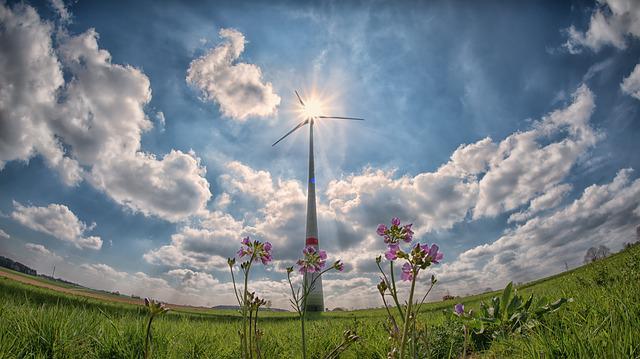
Global Wind Day or World Wind Day is celebrated on June 15, every year. The day marks the importance of enormous power possibilities that wind can provide as a renewable energy source.
Initially the day was announced by the European Wind Energy Association (EWEA) in 2007. Later in 2009 the EWEA joined hands with the Global Wind Energy Council (GWEC) and since 2009 it has been celebrated as a global event.

What is Wind Energy?
There are two types of energy sources; Renewable and Non-refundable energy. Where renewable and non-renewable energy sources consist of;
Renewable Energy Source:
solar energy from the sun, hydro energy, wind energy, tidal energy and geothermal energy from the heat inside the earth.
Non-renewable Energy Sources:
Oil, Natural gas, Coal, and nuclear energy. Where Oil, Natural gas, and coal are collectively called fossil fuels.
As we are aware of the fact that with the increasing population Mass on Earth, the demand of energy is also increasing simultaneously. So the Global focus is on increasing the capacity of Renewable Energy Sources and wind energy is one of the options for this.
Wind available in abundance can be utilised by Turbine; a device that converts wind energy into electricity. Mostly, areas away from dense population like coastline and desert area sites are suitable for establishing wind energy plants.
Importance of World Wind Day
It is truly said that “Solar power, wind power, the way forward is to collaborate with nature – it’s the only way we are going to get to the other end of the 21st century.”
Today most of our energy needs are fulfilled by fossil fuels only. But when they are burnt, a huge amount of CO2 and greenhouse gases is released in the atmosphere. These greenhouse gases are increasing the temperature of Earth and causing Global warming.
With the deepen climate crisis, world wind day is an effort to spread awareness about uses of wind energy, its power and possibilities to reshape the energy system. It’s an effective option to decarbonise the economies and boost job opportunities.
Advantages of Wind Energy
Here are some of the advantages of wind energy.
- Wind energy is not only nature friendly but also it is cost-effective.
- Wind energy which is available in abundance is also a source of clean fuel.
- Provided, India has a coastline of around 7,600 kms, we have a good prospect of harnessing offshore wind energy.
- This kinetic form of energy is way more effective than traditional sources of energy as fossil fuels are limited and are being used at a great cost to the environment.
Working of Wind Turbines
As we have discussed, wind energy is utilised by using Turbines. But how does the process actually work? Let’s have a look at it.
So the principle on which wind turbines work is that, like a fan- wind turbines use wind to produce electricity. When wind rotates the blades of a turbine around a rotor, it further spins a generator and then electricity is produced.
It should be noted here that the wind is generated due to;
- The uneven heat of atmosphere due to the Sun,
- The rotation of Earth and
- Irregularities of the Earth’s surface.
Now there are two types of wind turbines; The Horizontal Axis Turbines having three blades and operates upwind so the blades face into the wind and The Vertical Axis Turbines that are omnidirectional and don’t need any adjustments.
India’s Stand In Wind Energy
Talking about wind energy farms in India then Jaisalmer Wind Park is one of the largest wind farms in the world then Muppandal Wind Farm in Kanyakumari is also among the top ten. As of 30 May 2022, with its total Wind Power generation capacity of 40.53 GW India stands on the World ranking 4 in the world.
The state of Tamilnadu leads with 29% of total Wind energy generation in India. The total wind installed capacity in Tamil Nadu is 7633 MW.
Here are some quick facts about the Development of wind power plants in India.
- Development of wind power in India began in December 1952, with the initiative of Maneklal Sankalchand Thacker for a project with the CSIR to explore the possibilities of wind power in the country.
- The CSIR established a Wind Power Sub-Committee under P. Nilakantan to investigate the available resources that could be utilised, along with researching the economic possibilities of wind energy.
- In September 1954, a Symposium on Solar Energy and Wind Power was held by the CSIR and UNESCO in New Delhi; in the presence of E. W. Golding, an engineer and authority on wind energy generation and with recommendation extensive wind velocity surveys continued in India.
- In 1960, the CSIR established a Wind Power Division as part of the new National Aeronautical Laboratory (NAL) in Bangalore.
- India’s first wind power project of 40kw capacity began in 1985 in Veraval, Gujarat.
- In 1986, the Ministry of New and Renewable Energy established demonstration wind farms in the coastal areas of Maharashtra (Ratnagiri), Gujarat (Okha) and Tamil Nadu (Tirunelveli) with 55 kW Vestas wind turbines.
- In 2011, the potential wind farms in the country was first assessed with a capacity of more than 2,000 GW by Prof. Jami Hossain of TERI University, New Delhi.
- Today most of the wind energy is generated in Tamilnadu followed by Gujarat, Maharashtra, Karnataka and Rajasthan.
- As a result Wind power accounts for nearly 10% of India’s total installed power generation capacity.







